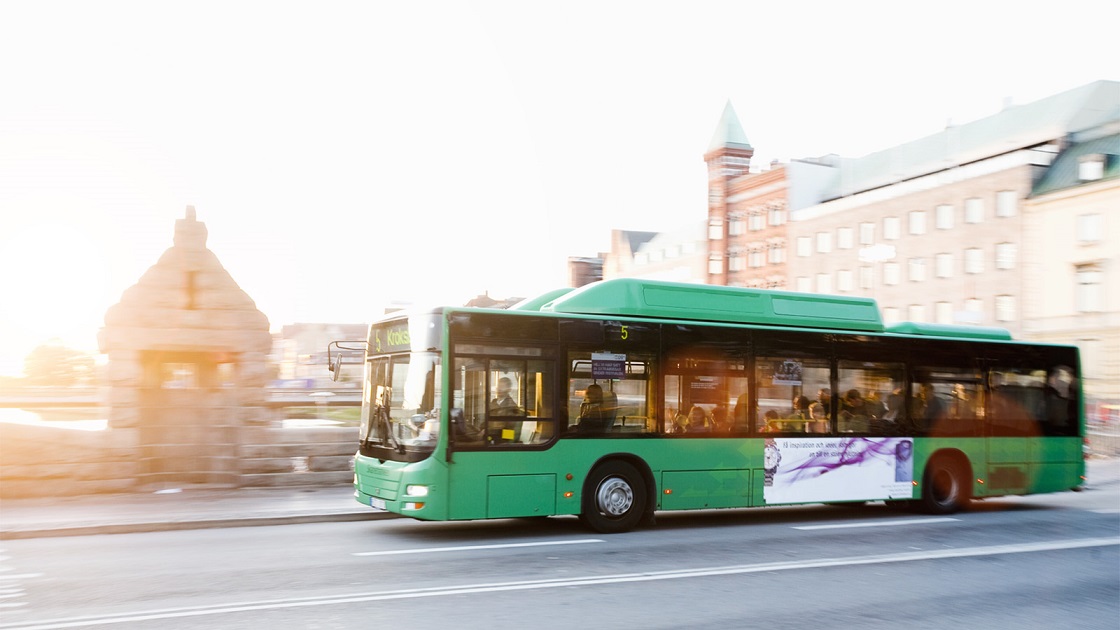
The ship floats peacefully in the deep blue water, surrounded by enormous cliffs and waterfalls. Here, in Norway's fjords the world seems to stand still. But the tranquility is just an illusion: The diesel engine starts, the cruise liner begins to move – and it’s loud. It’s not only the noise that disturbs the idyll, the ship also emits a lot of exhaust gases.
They often accumulate between the high mountains for days on end, which means smells and hazards for the health of the local residents. This is why Norway’s government wants to ban the dirty ships from the fjords soon – and replace them with environmentally friendly models, such as with electric drive systems. In the future, they will float past the snow-covered mountains quietly and emission-free.
It’s not only in Norway that conventional ship drive systems are contentious: Worldwide, maritime transport is responsible for almost 2.5 percent of total greenhouse gas emissions, according to the International Maritime Organization. It produces one billion tons of CO2 each year. The people who live in seaports, such as Hamburg and Rotterdam, are especially affected by this. Ships with electric or hybrid drive systems could be the answer. But can this revolution really succeed?

Why are ships becoming electric?
Ships transport about 80 percent of the world's commodities, reported the United Nations Conference on Trade and Development. And transportation across the oceans will continue to rise in the coming years – by 3.8 percent per annum by 2022. However, ships produce a huge amount of exhaust gases, such as sulfur oxides, nitrogen oxides, soot particles and fine dust, and also carbon dioxide (CO2). Market researchers at IDTechEx One have calculated that one single large ship emits as much CO2 as 70,000 cars, as much nitrogen oxide as 2 million cars, and as much fine dust and carcinogenic particles as 2.5 million cars. Out of the total global air emissions, shipping accounts for 18 to 30 percent of the nitrogen oxide. Because of this, ships are among the most serious sources of pollution in seaports.

Most container and cruise ships, oil tankers, and cargo vessels run on heavy diesel oil. And they consume enormous amounts: Together, the 90,000 ships worldwide burn 370 million tons of fuel each year – and produce 20 million tons of sulfur oxide. In inland shipping, on the other hand, marine diesel is used as a fuel, which is less harmful than heavy oil when it is combusted. In addition, fewer dangerous nitrogen oxides are emitted. The exhaust gases have disastrous consequences for the environment: The world’s climate is changing, the oceans are acidifying. There are health risks – from asthma in children to premature death.
The problem will get worse if conventional energies continue to be used as in the past. By 2050, air pollution could rise by at least 50 percent; in the worst-case scenario, even by up to 250 percent. A study by the EU parliament also assumes that by 2050 maritime traffic will be responsible for almost a fifth of global CO2 emissions. This puts at risk the targets of the Paris Climate Agreement, which specifies limiting global warming to well below two percent.
How emissions can be reduced
In April 2018, the International Maritime Organization decided to drastically reduce emissions. By 2050, the 173 member states of the UN organization want to at least halve CO2 emissions from ships compared to 2008. Since March 2018, fuel consumption of all ships, and consequently, exhaust emission, must be logged. Since 2020, only fuel containing no more than 0.5 percent sulfur may be used. Currently, the limit value is seven times that.
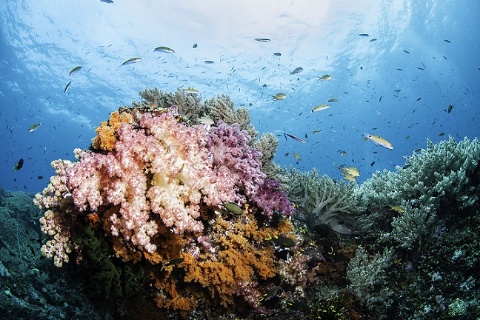
If the ambitious plan is to succeed, a change of thinking will be required. But what options are available to reduce emissions? There are various possibilities: For example, ships could install catalytic converters, similar to cars. These separate harmful nitrogen oxides into nitrogen and oxygen and a soot filter retains particulate matter. Or the ships could use marine diesel instead of the extremely dirty heavy oil. Marine diesel contains much less sulfur, but is much more expensive. Besides, both of these options have a significant disadvantage: They are based on an internal combustion engine and, consequently, fossil fuels. However, the mineral oil from which diesel is produced could be exhausted in 50 years at the current rate of consumption.
This is why the use of other energy sources is more efficient and cleaner, such as liquefied natural gas (LNG), hydrogen, or electric energy. Electrical drive systems are not just deemed to be sustainable on land and in the air. In many cases, the environmentally friendly alternatives to oil are suitable for inland shipping – and also for oceangoing ships in the distant future. One advantage of battery operation is that electricity is much cheaper than oil and, especially, marine diesel. Because of this, the analysts at IDTechEx predict that worldwide sales of fully electric and hybrid ships will increase. The figure could reach $20 billion by 2027.
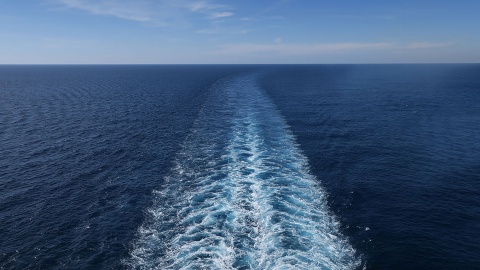
Ships have been “semi-electric” for many years
Ships were driven by the wind for thousands of years. But from the start of the 19th century, this task was increasingly taken over by engines. After the invention of steam engines and turbines, diesel engines in various forms were also used in the 20th century. They burn fossil fuels – diesel, heavy oil, gas oil. Traditionally, this type of drive is mechanical: The diesel engine drives a shaft that then moves the ship’s propeller. The engine or a generator also generates electricity for all the electrical systems on the ship.
But for several years, many ships have been partly electrified: 80 percent of oceangoing ships now use a diesel-electric transmission system. Diesel generators generate the electricity, which then drives the electric engine. This moves the ship’s propeller. This has many advantages: It saves between five and 20 percent of the fuel. The electrical machines also consist of fewer components, are less prone to faults, and have less wear and tear. This translates into reduced energy loss and higher efficiency. But this is still not a hybrid drive system. This is the case only if the ship can sail without the diesel engines running, at least for a certain length of time. In this case, the energy comes from the batteries on board. In the future, the electric engine could also be supplied with energy by other means, such as with rechargeable batteries, liquefied natural gas (LNG) or solar power.
The first electric ships
The first electric boat was tested on the St. Petersburg canals in Russia 1839. This was followed in 1886 by the “Elektra”, a test boat from Siemens & Halske. The City of Berlin in Germany tested it for local public transport. The boat had room for 25 passengers and sailed along the river Spree at 14 km/h. But the technology was not yet sufficiently mature and the batteries were too heavy. Development was not pursued any further. 25 years later, the electric ship “Akkumulator” sailed on Lake Königsee in Bavaria, Germany. It was also built by Siemens. Carrying up to 38 people, the boat could travel up to 100 kilometers with a fully charged lead battery. The concept proved to be successful: electrically driven pleasure boats still sail on the lake. The “Godesberg-Niederdollendorf”, an electrically driven ferry, sailed on the river Rhine in Germany from 1908 to 1945. In Sweden, the “Hamnfärjan” ferry was put into operation in 1913 to sail between the islands of Marstrand and Koön using an electric drive system.
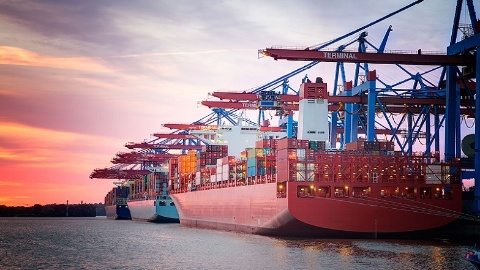
Electric ships – how does that work?
The journey from internal combustion engine to emission-free drive involves various technologies. As with cars, electric commercial vehicles or electric planes, hybrid technologies are an interim solution for models where it is still difficult to implement a purely electric drive system.
What technologies are already available?
-
- Diesel-electric drive: Diesel generators generate the electricity. The electricity then drives the electric engine, which moves the ship’s propeller.
- Hybrid drive: Batteries are on board in addition to the internal combustion engine. On the one hand, they can be switched on additionally for a short time when a power peak is needed. On the other hand, they can store surplus energy, such as from the diesel generator. This would allow the ship to sail using nothing but electricity for some time.
- Fully electric drive: There is no internal combustion engine on board, all the energy comes from batteries.
Some inland vessels already sail using nothing but electricity, mainly ferries and pleasure boats. That’s because they sail shorter distances and can therefore use smaller batteries. Several boat builders are also planning hybrid cruise ships. But for large cargo ships that sail the world’s oceans electric drives are still a long way away. The batteries are still not efficient enough and are too heavy for ships that sail long distances on the high seas.
Continued development in rechargeable batteries

For an electric drive system to be “worthwhile” on a ship, batteries must therefore become considerably more efficient. Work is being carried out in this area: With “SAVe Energy”, Rolls-Royce has developed a new battery system to electrify ships which has already been introduced in 2018. The company has been developing and producing energy storage systems since 2010, but in the past, the batteries came from external suppliers. The liquid-cooled system SAVe Energy is said to be highly efficient – and especially flexible: It can be used in fully electric or in hybrid ships, in ferries, cruise and cargo ships. With a liquefied gas or diesel engine, the system also provides support and reduces emissions. Initially, SAVe Energy will be delivered to Norwegian shipping company Prestfjord. Rolls-Royce expects a boost: In 2019 alone, shipping companies could install more batteries than in the eight years prior to this.
Alternative drive technologies
There are also other environmentally friendly alternatives to diesel, such as liquefied natural gas (LNG), which emits fewer pollutants and carbon dioxide when combusted. But LNG also has some disadvantages: On the one hand, a suitable infrastructure would have to be developed at the ports and on the ships. On the other, gas is also a fossil fuel and hence not infinitely available. In addition, gas can escape between production and use on the ship, what is known as methane slip. Methane has 25 times the effect of CO2 on the climate and contributes greatly to the greenhouse effect, says Germany's Nature and Biodiversity Conservation Union (NABU). Currently, about 200 of 50,000 oceangoing vessels sail with LNG or are preparing to do so. With the AIDA nova, the first cruise ship to sail using liquefied natural gas was put into service in 2018. Other shipping companies are also planning cruise liners with LNG drive systems. US-based Royal Caribbean plans to sail two cruise ships with fuel cells in the future. They burn liquefied natural gas as a fuel.
Technology group ABB and fuel cell producer Ballard are also backing fuel cells, but with an alternative, clean drive. They convert chemical energy into electrical energy. This energy then drives an electric engine. There is no combustion and no exhaust gases. ABB and Ballard want to make the existing technology also possible for larger ships. In spite of electric power of three megawatts and 4,000 HP, the system will not be larger than an internal combustion engine. The companies are focusing initially on large passenger ships. However, there is as yet no reliable time schedule for the project. Ballard has more plans: from 2021, the world's first hydrogen-powered sea-going ferry "HySeas III” will sail between two Scottish islands using fuel cells from the Canadian producer.
Solar boats are also on the water: the catamarans “SolarWave” and “Tûranor PlanetSolar” obtain their energy from photovoltaic cells on board. In 2012, the “Tûranor PlanetSolar” was also the first solar-powered boat to sail around the world. The journey took 585 days.
The main challenges
For there to be more electric ships in the future, one main challenge has to be overcome: The batteries to store electricity must be much more efficient. To date, their energy density is still too low. That means the batteries cannot store enough energy in relation to their size and weight. Large oceangoing ships have to travel vast distances with one battery charge – the batteries for this are generally still too large and too heavy.
In addition, the ports need a suitable charging infrastructure. This is already an issue with shore-side electricity, since cruise ships need electricity continuously for their hotel operations when docked. Often, they generate this with motors and auxiliary power units – and emit pollutants. It would be much more environmentally friendly to purchase the electricity directly in the port. However, shore-side electricity facilities such as this are still rare. The ports would therefore have to invest a lot of money for charging equipment. The batteries are also still too expensive for many shipping companies. According to DST, a development center for maritime technology and transportation systems in Germany, batteries are the most expensive component on an electric ship.
Nevertheless, electric drive systems are still possible for ferries and inland vessels. They dock frequently and can either exchange batteries in containers or briefly recharge the batteries every time they dock and charge them completely overnight.
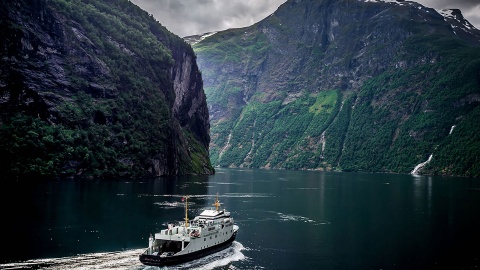
Electric and hybrid ships in use
Several hybrid and fully electric ships are already in use. Where are they – and what distances are they already capable of?
Hybrid technology on ferries and cruise ships
The four ferries of what is known as the “bird flight line” between Germany and Denmark already sail with hybrid technology. The drive combines an internal combustion engine and an electric drive system. According to the shipping company, this reduces CO2 emissions by up to 15 percent. The “Vision of the Fjords” on Norway's Nærøyfjord is also a hybrid ship: the electricity for the drive comes from diesel generators and from batteries. They have a capacity of 600 kWh. The batteries are charged while the ship is sailing with the surplus energy from the diesel engine and, when it is docked, with clean hydro-electric power. The ship can sail for three hours with the power from the batteries.
As the first hybrid-electric powered cruise ship, “MS Roald Amundsen” from Norwegian shipping company Hurtigruten was introduced in 2019. Lithium-ion batteries will enable the ship to sail for at least 30 minutes with electric power. The benefit for the passengers is that they glide in complete silence along Norway’s coats and later along the icebergs of Antarctica with no exhaust gases.
Fully electric ferries and container ships
To date, it is mainly ferries and small passenger ships on inland waterways that sail completely with electricity. They sail only short distances and dock often. The energy storage units can thus be recharged quicker. In Norway, the world's first vehicle ferry has been operating a regular scheduled service since 2015. The 80-meter-long “Ampere” sails back and forth on the Sognefjord between Lavik and Oppedal 34 times per day. Each time, it sails six kilometers, almost silently and with no exhaust gases. The ferry was developed by Siemens together with Norwegian ship builder Fjellstrand. Packages with lithium-ion batteries are installed in the ship and at both ports. Each of these has the capacity of 1,600 automobile batteries. At each 10-minute stop, the ferry's batteries are charged briefly and are charged completely overnight. The electricity is from a hydroelectric power plant. Thanks to its lightweight aluminum design, the Ampere is only half the weight of a conventional vehicle ferry, despite the 11-ton battery. It saves a million liters of diesel each year and its operating costs are about 80 percent lower. Its CO2 emissions are only five percent of those of a conventional ferry.
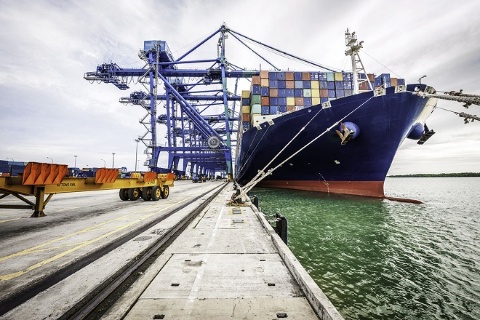
A fully electric ferry has also been sailing on the river Mosel in Germany since spring 2018. The “Sankta Maria II” transports 45 passengers and six cars. Some of the electricity is generated by 15 solar modules and is stored in two battery blocks. They have a capacity of 252 kilowatt hours. This enables the ferry to sail for 6.5 hours. Electric ferries also sail on other rivers: on the Ruhr in Witten, Germany, two electrically powered ships are in use and in Berlin the four solar-powered ferries “FährBär 1 to 4” have been sailing on the Spree since 2014. Amsterdam wants to ban all diesel-powered passenger ships and ferries from the city canals by 2025.
China has the first fully electric container ship – initially as a trial on Pearl River in Southern China. It is planned only for use on inland waterways, as the ship can travel a distance of just 80 kilometers. The 1,000 lithium-ion batteries on board weigh 26 tons and achieve 2,400 kilowatt hours. Norway is also working on an electric container ship: From the early 2020's, the “Birkeland” will transport chemicals and fertilizer from the plants of manufacturer Yara to the port in Brevik. The company uses trucks for this at present – around 40,000 trips per year. The ship will transport 120 containers.
Dutch company Port-Liner is also building fully electric cargo ships. They will sail on inland waterways, including to Rotterdam port. They can travel for 34 hours on one battery charge. The batteries are in containers that are simply exchanged at the port, which means that they do not have to be charged immediately. Port-Liner plans to produce 15 electric ships for the Netherlands and Belgium in the coming years.
Traveling through Norway with electricity
Norway is a pioneer in electric mobility, not only on the road and in the air, but also on the water. The first electric ferry has been operating a schedule service since 2015. In the middle of 2018, the government passed a law declaring that from 2026 only ferries and ships with hybrid or battery-powered systems may sail on the country's fjords. This poses challenges for the operators: Each year 300,000 cruise ship tourists visit the famous Geirangerfjord, for example.
But Norway has great plans for electric shipping: The Ulstein shipyard is building the world’s largest hybrid powered passenger ship for the Color Line shipping company. It will sail around Southern Norway with up to 2,000 passengers on board. As soon as the ship approaches the port at Sandefjord, the diesel engines will be switched off. The ship can sail for an hour using electric power. Hurtigruten has signed an agreement with Rolls-Royce: Up to nine cruise liners will be converted from diesel to hybrid drive systems. Transportation company Fjord1 plans to operate seven electrically powered ferries from 2020.

How does Infineon contribute to electric shipping?
In the future, more commodities and also more passengers will be transported on electric ships. This increases demand for power semiconductor devices. With these, Infineon promotes the development of electromobility also on the water. Ships could not sail electrically without the power semiconductor devices in their powertrain. Various manufacturers use converters with components from Infineon in their systems and engines. They convert direct current from batteries to alternating current for the engines.
Electric and hybrid ships need more efficient and lighter batteries for a breakthrough. While the energy density has increased considerably over the last 30 years, it is not yet enough to supply large ships with energy for long distances. Infineon helps overcome this obstacle: The battery units are becoming smaller and lighter, because the system efficiency is improving. They are utilized better with what is known as battery balancing. That means they work more efficiently. Battery balancing can increase the capacity and life of batteries by more than ten percent.
But the development of charging infrastructure and technologies for faster charging of the batteries is crucial. Here, too, products from Infineon can help: They can decrease the charging time considerably, for example, thanks to innovative materials such as silicon carbide (SiC). Silicon carbide can process higher loads and voltages than silicon – and it needs less installation space in the system because power dissipation is lower.

Outlook
Climate change, regulations, costs: In the coming years, shipping will have to change to environmentally friendly drive systems. This is why we will see an increasing number of electrically powered ferries and passenger ships. However, ships are in use for decades. Generally, cargo ships operate for 30 years, inland vessels for about 45 years, and passenger ships often longer. In other words, it will take some time before the shipping companies replace them. More than 7,300 cargo ships are in use alone in the EU. The Dutch electric ship builder Port-Liner assumes that it will take about 50 years until all of them have been replaced by electric models – at least at the current rate. Experts predict that it will be at least 20 years before we see the first fully electric oceangoing ships. The better the alternative drives work, the quicker this will happen. If battery density also increases and batteries work more efficiently, many ships will in future sail quietly and in an environmentally friendly manner.
In other words, electricity will also drive the ship’s propeller in the future. But development continues; next, there will be no need for a captain on board. Specific plans for this already exist: The Birkeland, the container ship from Norwegian company Yara, will soon sail with a small crew – later autonomously. In 2030, less than 550 years after Columbus, the first enormous steel ships could be steering into the future autonomously and electrically.
Last update: July 2021




